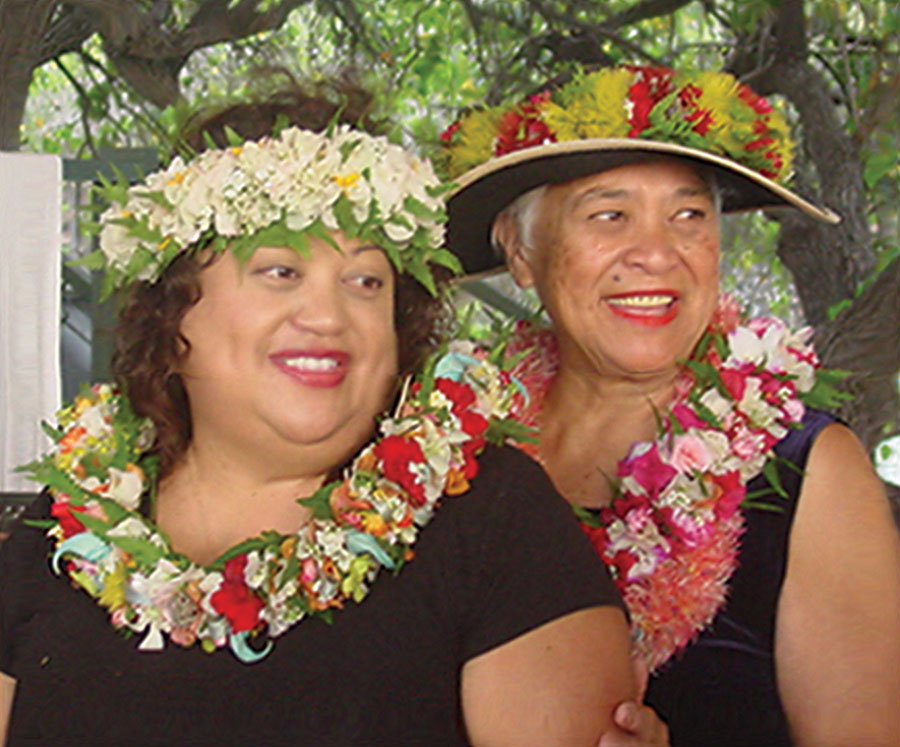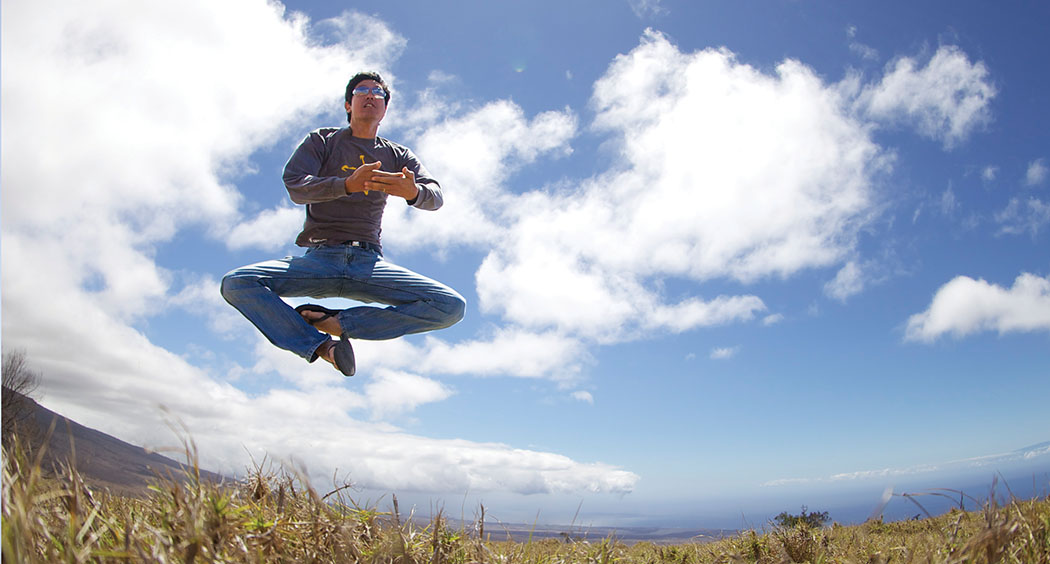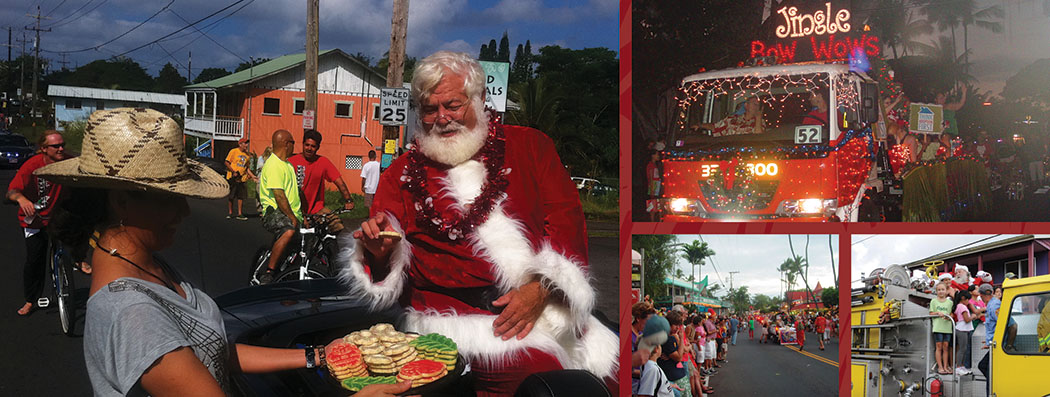
Kalani Honua: Creating Heaven on Earth—Earth Art, Tomato Teachings, and Hula Blessings

Kalani staff circle: Beginning with Wailana Simcock (clockwise from 1 o’clock), one of many choreographer-dancers at the eco-village; Shola Ricco, florist and dance meditation instructor, Davey Groth, ukulele leader; Eric Flail and Chris Pell, aesthetics masters; Wilbert Alex, Trance Dance facilitator; Maxwell, Ariya and Ayako Starkhouse, multi-talented family funsters; Lewie Pell, cottage steward, story teller; Jared Sam, yogi, groups coordinator; and Tiki DeGenaro, general manager.
By Marya Mann

On a sun-drenched afternoon, I find myself walking the sacred grounds of Kalani Honua, the original nature, wellness, and Hawaiian cultural eco-village in the heart of Puna’s lush, green southern coast. Richard Koob, dancer, farmer and raconteur who started the center in 1975, guides me past a reclining Buddha sculpture on the way to the aquaculture gardens.
He offers me a plump tomato, fresh from the hydroponic vine.
Who can resist? I take a juicy bite. My palette purrs. Delicious! Potent, healthy, natural. Genuine food, energy medicine, an antidote for much that ails modern, industrial society.
“Good, huh?” says Richard.
“Ommmmm,” I moan in culinary ecstasy.
A light turns on. Om? Om. Suddenly, like a shooting star across the heavens, I know the source of Om: yummy foods, central characters in an East-West Garden of Eden, free of guilt and terror.
The magical mantra Om, like the sweet sound of Aloha, is said to repel fear, instill love, and guide devotees, even nonbelievers, across stormy seas of existence and into safe harbor.
Art of Cultivating Delight–A Tomato Worthy of Its Name
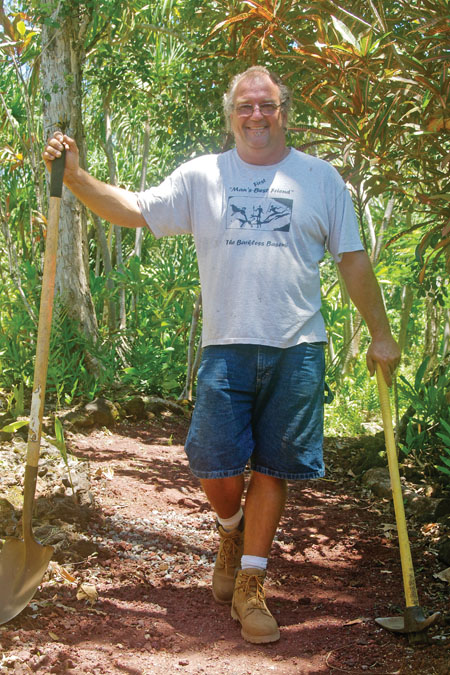
Kalani IS safe harbor for thousands of pilgrims and other eco-visitors who reside, study and volunteer at the 120-acre learning center every year.
They all seem to realize one thing: To be worthy of the name “tomato,” a tomato must taste like a tomato. Words, like many of the styrofoam-tasting vegetables you find in corporate grocery stores, can become stale. Or words can be juicy, fresh, real.
Consider Kalani Honua, words which translate into “harmony of heaven and earth.” Can there be a place worthy of the name? Like the words aloha and enlightenment, Kalani Honua could be disregarded for the many concocted reasons we might choose for ignoring the treasures around us.
Respect, still a fresh word, comes from the Latin respectus, which means “to look again.”
Looking again, travelers and Big Island residents return often to Kalani Honua to live naturally, enjoy ‘ohana, and create dance, music, and visual arts that celebrate Hawaii’s cultures. On-site and on-the-web, more than a quarter of a million people visit the eco-village every year. An anchor for the artistic, economic, and social life of Puna for 35 years, Kalani is also a campus seedbed for the 22nd century, both literally and figuratively. Drawing on the creative energy of Pele’s lava, flowing directly into the sea nearby at Kalapana, nearly 100 residents work, play, heal and create.
Complementing hundreds of food production, holistic health, art and human development workshops held here every year is the rare experience of eating, playing, and evolving side-by-side with masters in the living, agrarian and performing arts. You get dirt underneath your fingernails, you feel your feet in the earth, you discover a new way of dancing for the sun, or all three.
Art of Nature–Being One with Life
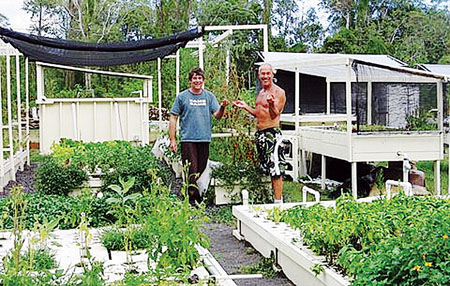
Kalani rests in a kīpuka, an apt and underused word meaning “protected place where the lava didn’t flow.” Working in this vast green oasis requires strong legs for long treks. Consider Barcus Adams, Kalani’s agriculture director who came to Kalani five years ago and hasn’t stopped walking, on and off the paths, ever since.
Planning all year for a late October Eco-Fest, Barcus still found time to practice another art, writing about his quest for the Kalani community blog (www.kalani.org/blog):
“All this time my feet were taking me all over Kalani. I have gone into areas that humans have not gone in decades if not centuries. On one of those walks I came across an area that was dominated by invasive, non-native plants. These I knew would have to come down. So I began thinking of what to replace them with, when it came to me the idea of turning it into a nursery spot. So I put it before my crew who thought it was a big job, but also who knew my favorite word was Ho’omau, determined.”
Ho’omau. A fine word: determined. He goes on:
“Ahhhhhh, I love my feet. They always keep taking me one step closer to my dreams!”
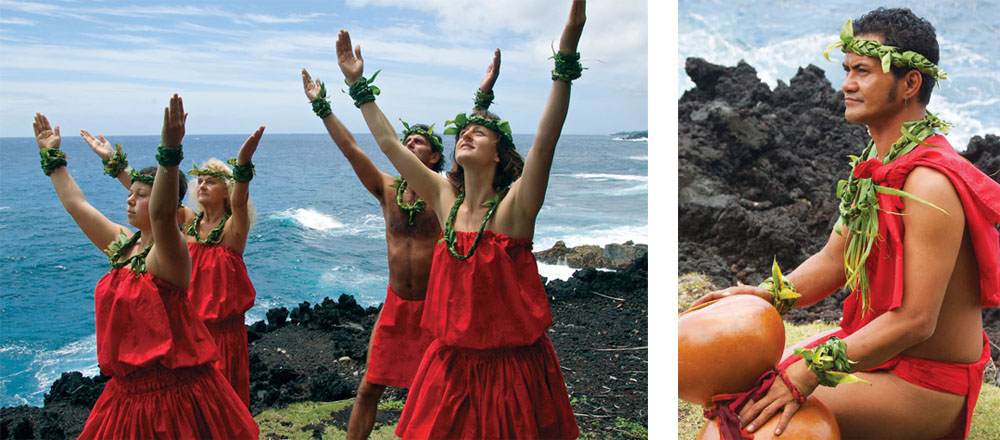
Art of Dance–Moving with Clear Intention
If Barcus represents the earth of Kalani, Filipino dancer Wailana Simcock is the sky. He teaches and choreographs new hula, modern, and aerial dances, and has the longest arms of anyone I’ve ever met. When he sweeps them out and up in one of his skyward leaps, you actually see the harmony of heaven and earth in his body, his toned torso, his bronze limbs.
Dancing professionally since he was 22, Wailana began living full-time at Kalani two years ago after a successful performance career in San Francisco. He credits Buddhist contemplative arts teacher Barbara Dilley for opening his eyes to “Kinesthetic Delight” meditations that enhance new dance ceremonies and performances.
“Hula keeps me grounded in my environment, while modern dance is where all the worlds come together. In modern, a new language can be developed. Even hula has a language that’s being developed right now as I write a kala‘au number (with Hawaiian sticks) for the Eco-Fest performance.”
Wailana says integrating the evocative, natural movements of traditional hula with other dance, aerial trapeze and French tisu dancing invigorates him. “I’m finding my own vocabulary here because I’m really influenced by Hawai’i, by the ‘āina, the land, and the people.”
On the wall across from Wailana’s simple wood desk hangs a dazzling photograph, a lei of giggling, blissful faces. Grandmothers, brothers, uncles, sisters, all with flowers dancing in their hair. ‘Ohana. Kalani’s staff.
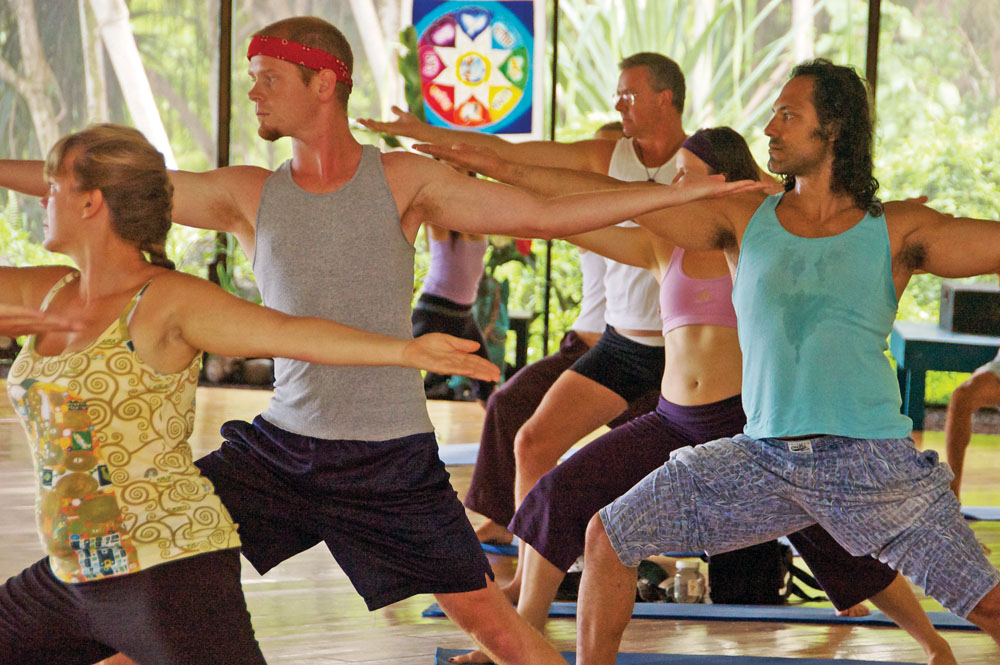
Next to the staff circle is Kalani’s weekly schedule-at-a-glance, listing more than 40 activities open to the public, many of them free: Hula with Kimo, Lauhala Weaving with Auntie Lynda, Hawaiian Healing with Stewart. Kundalini, Ashtanga, Anusara, and Intuitive Yoga classes. T’ai Chi, Spirit Sculpting, drawing and volleyball. Nature walks, meditations, and numerous dance forms. “Sometimes people will trade us for classes with a couple of papayas,” says Wailana, “and that’s okay, but we still need to make a living.”
Kalani also hosts hundreds of popular retreat workshops every year, and was honored as the favorite locale for the 2010 International Conference of Retreat Centers, a group which includes Esalen, Omega, Kripalu, and other respected wisdom centers.
The sustainable education programs at Kalani are distinctive because Hawaiian cultural traditions are threaded into daily life. “We’re living eco-sustainably and helping the community,” says Wailana. ‘It’s agriculture and dance, but it’s beyond dance. There are some things besides plants and the o’o (Hawaiian extinct bird) that are worth saving, like loving.” As I leave to meet Richard for lunch, passing the 25-meter Olympic swimming pool, roomy Jacuzzi, and warm aquatic bodywork pond, amid a riot of orchids, I smell something like jasmine and hear a hum in my ears. Maybe it’s the sound nature makes when it’s pleased with us, the sound of tomatoes growing and dancers stretching their toes.
The Art of Eating–Eat Wisely

We sit down to an open-air feast, a typical meal at Kalani, within chanting distance of an authentic Native American sweat lodge. Surrounded by every shape and texture of greenery you can imagine, the women and men in kerchiefs, pareos, and work clothes come in all shapes, shades, and sizes too, but they have one thing in common: so serenely, they float rather than walk to their tables.
The curator of the National Museum of Berlin is here on sabbatical and, along with a cosmopolitan group from ages 20 to 90, we chow down on fresh salad, pumpkin curry and pad thai. “We’re an arts and agrarian community,” says Richard, blue-green eyes like the sea, wearing a turquoise necklace, t-shirt and shorts. “I grew up in a big, Minnesota-friendly family, balancing skills learned from my farmer-businessman dad and my church musician-gardener mom,” he says. “They both respected that life is sacred, sometimes tough, and certainly fun.” Richard, now 64, who holds an MFA in Modern Dance from UH Manoa, spawned the Kalani vision for a sustainable arts community nearly four decades ago with his partner, Hawaiian-born Earnest Morgan, who died of AIDS in 1992.
“In the early days, we learned how to live and grow food, to practice hula and maintain the heiau and halau. Now Hawaiians at Kalani and their alaka’i (assistants) continue to share this knowledge with others.”
“The evolution of Kalani is a continuing creative project,” he says. “With retreat clusters now being built, like the 16 renewable, bamboo and wood cottages, people who share Kalani’s nature-culture-wellness and educational focus can invest, live here, and become stewards of the land.”
Art of Learning–Find Yourself Here
If Richard Koob performs as the head of Kalani Honua, Opihikao native, 100-percent Hawaiian, Dottie Kyser and her daughter Nikki Florendo are the heart and hands.
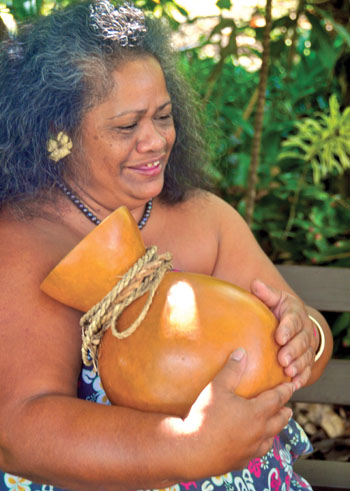
“I’ve been part of Kalani since I was nine,” says Nikki, who greets everyone at the Kalani front desk, while Dottie manages the bookstore. “Being here, growing up here, exposed me to stuff I wouldn’t ordinarily do. I studied meditation and yoga. I took a massage class and learned a new skill to help people.” Though Kalani is run primarily by volunteers, the 10 paid staff members work diligently to bring Hawaii’s aloha to the rest of the world. Blending dance, music, yoga, arts and wellness with land stewardship and food production, Kalani’s merry band of creators say their idea of an extreme planetary makeover is deeply rooted in Hawaiian soil.
“Hawaii’s story is that of creation,” says Richard. “From bon dancing in the East to barn dances in the West, with hula in-between, anywhere there has been agriculture for the last 9,000 years, there has most likely been dance, shamanism, performances, theater, and healing ceremonies.
“We’ve learned from nature and traditional Hawaiian cultures,” he says. “It brings aloha to everything we do. We don’t need to be so focused on GNP as in Gross National Product. That’s gross. We need to grow Great Natural Happiness, similar to Bhutan, but in a more democratic way.”
In a classic Kalani art collaboration, the Kalani team is creating a fresh ceremony for an ancient holiday, Winter Solstice, longest night of the year. This year, Solstice shares a rare astrological moment with an eclipse of the moon, and the December 20th events at Kalani will feature ethnomusicologist and snake dancer Jim Berenholtz (co-founder of the musical duo Xochimoki), universalist painter and visual artist Mark Kadota, and Kona’s own Yoga Dance for the Worlds in a first-ever Solstice Moon Eclipse-of-the-Ego Eco-Celebration.vFor happiness—like Om and Aloha—is what makes gardens, time, and art forever fresh and the world always new. And that is no ordinary tomato. ❖
Resources:
- To view Kalani Honua’s history, cultural garden plans, blog, and current schedule: www.kalani.org
- To learn more about the Land Stewardship program at Kalani Kai: www.kalani.com/community/kalani-retreat-village
Contact Marya Mann at marya.mann@gmail.com
